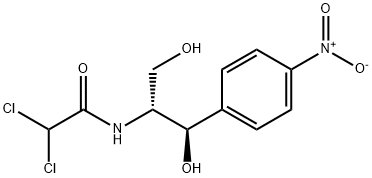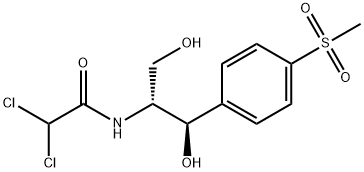Amphenicols Drugs
Amphenicols (chloramphenicol) antibiotic mainly include chloramphenicol and thiamphenicol. Nowadays, there are countries which are studying the fluorine-containing compound in order to obtain drugs with stronger membrane penetration capability, low toxicity, and better efficacy in killing microorganisms. Chloramphenicol was extracted from the culture of Streptomyces venezuelae and is now mass-produced through chemical synthesis. This product is in L-body form. Chloramphenicol antibiotics can act on the 50S subunit of the bacterial ribosome, interfering with the protein synthesis, belonging to a broad-spectrum antibacterial antibiotic.
The 70S ribosome of the bacterial cells is the major cellular components for protein synthesis. It is comprised of two subunits 50S and 30S. Chloramphenicol, through reversibly binds to the 50S subunits, blocks the action of the peptidyl transferase, interfering with the process of the binding of amino acid containing- aminoacyl-tRNA with the 50S subunits, resulting in the blocking of formation of new peptide chain, thus causing inhibition of protein synthesis. Since chloramphenicol can also bind with the human mitochondrial 70S ribosome, and thus being capable of inhibiting the mitochondrial protein synthesis in the human body, thus producing toxicity to the human body toxicity. Because the binding between chloramphenicol and the 70S ribosome is reversible, it is considered as bacteriostatic antibiotics. However, it also has bactericidal effect on certain kinds of bacteria at high drug concentrations with significant bactericidal effect on the influenza bacilli even at lower concentrations.
【Clinical application】
Since chloramphenicol can cause serious side effects, it is clinically applied only to the treatment of the typhoid infection, influenza bacillus infection, and severe Bacteroides fragilis infection caused by susceptible strains as well as to patients of brain abscess, Streptococcus pneumoniae, or meningococcal meningitis who are allergic to penicillin allergic. During the application, it should be avoided of an extra-long treatment course. Patients with a history of drug-induced hematologic abnormalities should be disabled. All patients who will be subject to chloramphenicol treatment should be subject to inspection of the white blood cells, reticulocytes and platelets at the beginning of treatment with repeating every three to four days. If leukopenia occurs, the drug administration should be discontinued immediately. Infant should be cautious upon administrating chloramphenicol and should be considered to be subject to chloramphenicol treatment only in case of having no alternative drugs and thus must apply it. The blood concentration monitoring should be carried out if possible.
Thiamphenicol and chloramphenicol belong to the same kind of antibiotic with only the nitro group in the benzene ring of chloramphenicol being substituted with a methyl sulfone group. It has a similar antibacterial spectrum as chloramphenicol. Thiamphenicol is mainly excreted from the kidney with the urinary active concentrations being higher than chloramphenicol, so the dosage should be reduced upon poor kidney function. Although there is also blood toxicity, but they are all considered as reversible changes and it will not cause aplastic anemia. Some countries believe that its efficacy is superior to chloramphenicol, but in china it is believed that the effect is not better than chloramphenicol.
[Pharmacological Properties]
It belong to broad-spectrum antibacterial agents and can penetrate into the bacteria cell through its lipid solubility with its major target on the 50s subunit of bacterial 70S ribosome. It inhibits the activity of peptide transferase, hindering the growth of the peptide chain and inhibiting the formation of the peptide chain, thereby preventing protein synthesis. At high concentrations, it also exhibits bactericidal effect against the bacteria which are highly sensitive to these goods.
Chloramphenicol generally has a stronger effect on gram-negative bacteria than gram-positive bacteria. Susceptible bacteria include Enterobacteriaceae (such as Escherichia coli, Enterobacter aerogenes, Klebsiella, Salmonella, etc.) and Bacillus anthracis, Streptococcus pneumoniae, Streptococcus, Listeria, Staphylococcus aureus. Chlamydia is also sensitive to the chemicals, Leptospira, Rickettsia. This product has certain effect on anaerobic bacteria such as Clostridium tetani, Clostridium perfringens, actinomycetes and lactic acid bacteria and Fusobacterium. However, it is ineffective in the treatment of Pseudomonas aeruginosa, Mycobacterium tuberculosis, viruses, fungi, etc.
There is slow development of bacterial chloramphenicol resistance, mainly through producing acetyltransferase and obtaining it through plasmid transfer. Some strains of certain bacteria (Pseudomonas aeruginosa, Proteus, Klebsiella) also have chloramphenicol resistance due to changes in the bacterial cell wall permeability.
[Resistance]
Resistance is most commonly in Escherichia coli, Shigella and Proteus but rarely happens in Salmonella typhi and Staphylococcus. The development of bacterial resistance to chloramphenicol is relatively slow, possibly generating through gradual mutations but can disappears automatically. Bacteria can also acquire chloramphenicol resistance through the transfer of the R-factor. Bacteria acquiring R-factor can produce bacterial chloramphenicol acetyl transferase enzyme to inactivate chloramphenicol.
Pharmacokinetics
The medicines is easily absorbed through animal oral administration with the plasma concentration reaching peak at about 2 hours, and is widely distributed in the body with also higher concentration in the gut. It is not only capable of penetrating into the milk and fetal circulation, but also penetrating through the blood-brain barrier and entering into the cerebrospinal fluid. It can also be incorporated into the ascites and pleural effusion.
Taboo
It can cause gray baby syndrome in Newborns thus should be disabled. It can cause severe reactions for psychosis patients and should also be disabled.
Adverse reactions
(1) Bone marrow disorders; there may be cytopenias with aplastic anemia occurring in severe cases. Few people obtain hemolytic anemia and sideroblastic anemia.
(2) Neurological manifestations; enhanced excitability in central nervous system with insomnia, paranoia and depression occurring in light cases and hallucinations, mania, delirium and ataxia in severe cases. Mental disorders can also be observed in some cases. Peripheral neuropathy is more common observed in the retrobulbar optic nerve and auditory nerve, may cause vision and hearing impairment.
(3) Allergic reactions; mainly exhibit as drug eruption, exfoliative dermatitis and drug fever;
(4) Gastrointestinal symptoms, nausea, poor appetite and vomiting. Patients of liver damage can obtain jaundice and abnormal liver function.
Precautions
Including chloramphenicol, thiamphenicol and tasteless chloramphenicol; Chloramphenicol belong to broad-spectrum antibiotic but has been less used due to its large toxicity to the blood system. Topical administration of its eye drop can cause prevention and treatment of eye infections. Note:
① the main adverse reactions include neutropenia and thrombocytopenia, aplastic anemia;
② long-term administration can cause optic neuritis, ataxia, and superinfection.
③ sometimes gastrointestinal reactions.
④ for newborns, it can cause gray baby syndrome and should be disabled;
⑤ for mental patients, it can cause severe reactions and should be disabled.
⑥ Intramuscular administration is prone to cause serious reactions. Thiamphenicol has a similar antimicrobial spectrum with chloramphenicol and will not cause aplastic anemia. However, patients of poor kidney function should reduce the dosage. Children can take tasteless chloramphenicol.
Medicine interactions
Compatibility Note: This product of its injection, in case of strongly alkaline and acidic solution, is easily damaged and gets failure.
(1) Macrolide and lincomycin antibiotics have similar antibacterial mechanism of action as chloramphenicol, and can be used as substitute of chloramphenicol to bind to the 50s subunit of the bacterial ribosome. Therefore, the combination between them can be antagonistic and should be avoided.
(2) Chloramphenicol is antibacterial agent that inhibits bacterial protein synthesis and can interfere with the bactericidal effect of penicillin bactericidal agent. It should be avoided of the combination of two types of drugs.
(3) Chloramphenicol can antagonize vitamin B6, increasing the body of B6 requirements. It can also antagonize the hematopoiesis of pro-vitamin B12.
(4) Chloramphenicol has inhibitory effect on the drug metabolism enzyme contained in the liver microsomes and can affect the efficacy of other drugs such as significantly prolonging the animals anesthesia time with pentobarbital.
(5) The product, when used in combination with some drugs of bone marrow suppression such as colchicine, phenylbutazone and penicillamine can further increase the toxicity.
- Structure:

- Chemical Name:Chloramphenicol
- CAS:56-75-7
- MF:C11H12Cl2N2O5
- Structure:

- Chemical Name:Thiamphenicol
- CAS:15318-45-3
- MF:C12H15Cl2NO5S
- Chemical Name:CHLOROAMPHENICOL VETRANAL
- CAS:
- MF:
- Chemical Name:Chloromycin succinate
- CAS:
- MF: